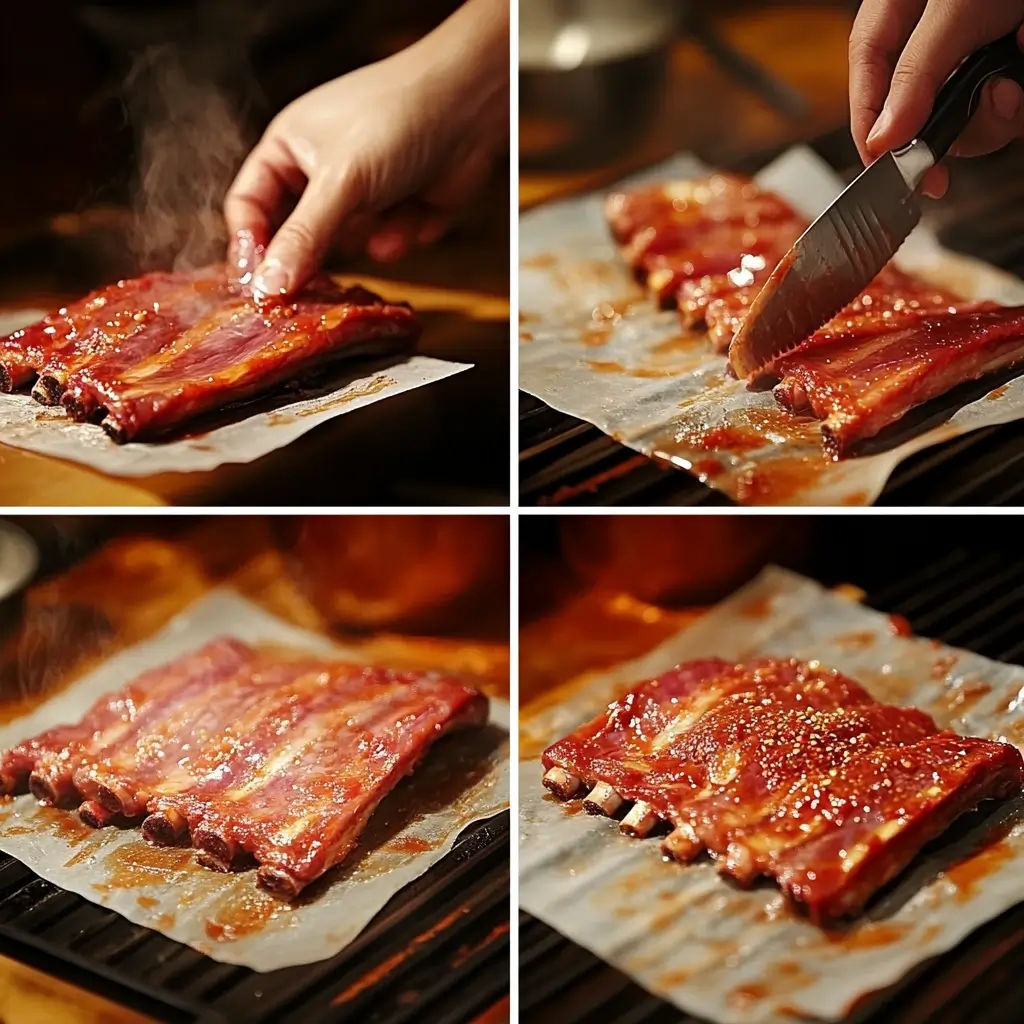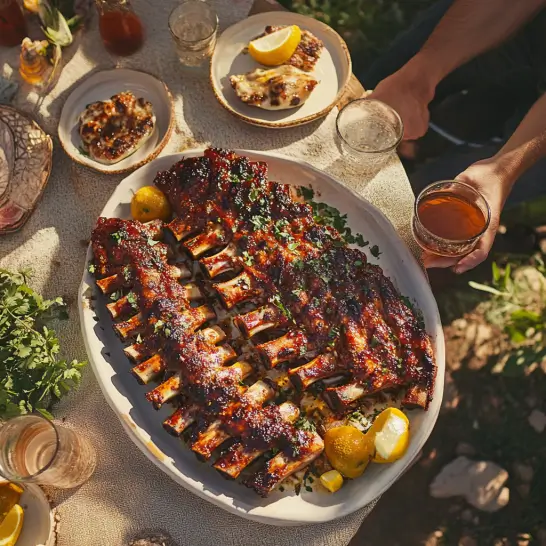- Introduction to Party Ribs
- Choosing the Right Type of Ribs for Your Party
- Preparing Your Party Ribs: A Step-by-Step Guide
- Cooking Methods for Perfect Party Ribs
- How to Know When Your Party Ribs Are Done
- Sauces and Glazes: Adding the Finishing Touch
- Serving Suggestions for Your Party Ribs
- Troubleshooting Common Rib Issues
- Creative Ribs Recipe Variations for Every Taste
- The History of Ribs: A Culinary Tradition
- How to Store and Freeze Ribs for Future Use
- Pairing Ribs with Different Types of BBQ Styles
- How to Create the Ultimate Rib Feast: Party Planning Tips
- Dietary Considerations: Can Ribs Be Made Healthier?
- Conclusion: Mastering Your Party Ribs Recipe
Introduction to Party Ribs
Ribs are a culinary delight that can transform any gathering into a memorable event. To begin with, the party ribs recipe offers a perfect balance of flavor, texture, and presentation. Whether you are hosting a backyard barbecue, celebrating a special occasion, or simply enjoying a casual get-together, ribs can be the centerpiece of your menu. In addition, their versatility allows for endless possibilities, from sweet and smoky to spicy and tangy flavors. Moreover, they pair well with a variety of sides, making it easy to customize your meal to suit any taste.
Furthermore, the preparation process can be as simple or as elaborate as you prefer, accommodating both novice cooks and seasoned grill masters alike. For instance, you might choose to focus on quick marinades and high-heat grilling for a fast meal or dedicate extra time to low-and-slow smoking techniques for unparalleled tenderness. Not only that, but experimenting with unique spices, herbs, and sauces allows you to craft a signature flavor profile that sets your ribs apart from the rest.
In this guide, we will take you through every aspect of making ribs the highlight of your party. Step by step, we will discover how to select the best cuts of meat, prepare them with care, and cook them to perfection. Additionally, we’ll share insights on creating the perfect balance of flavors and textures to impress your guests. Along the way, we will provide tips for enhancing flavor with marinades, dry rubs, and sauces. Finally, we’ll offer advice on serving and presentation to assure your dish is not only delicious but also visually stunning. Ultimately, our goal is to guarantee your guests leave with full bellies, happy memories, and a newfound appreciation for your culinary skills.
Choosing the Right Type of Ribs for Your Party

Selecting the right type of ribs is essential to achieving the best results. There are several types to choose from, each with unique characteristics:
Beef Ribs: Ideal for those who prefer a hearty, beefy flavor, though they require longer cooking times.
Baby Back Ribs: Known for their tenderness and lean meat, they cook relatively quickly and are perfect for small gatherings.
Spare Ribs: Larger and meatier, these ribs have more fat, which contributes to a rich flavor.
St. Louis-Style Ribs: A trimmed version of spare ribs with uniform shape, making them easier to handle and cook evenly.
For inspiration on creative dishes, try ideas like pork riblets recipes for variations that cater to every palate.
Preparing Your Party Ribs: A Step-by-Step Guide
Preparation is key to delicious ribs. Follow these steps to guarantee your ribs are party-ready:

Remove the Membrane: Flip the ribs and locate the thin membrane on the bone side. Use a knife to loosen it, then peel it off with a paper towel for better seasoning absorption.
Trim Excess Fat: While some fat improves flavor, excessive fat can lead to flare-ups during grilling.
Season Generously: Apply a dry rub or marinade, ensuring it penetrates the meat. Let the ribs sit for at least an hour or overnight for maximum flavor.
Preheat Your Cooking Equipment: Whether grilling, smoking, or baking, guarantee your equipment is ready before starting.
Need tips? The Pork Con Tiki recipe guide is an excellent resource for mastering unique preparation techniques.
Cooking Methods for Perfect Party Ribs
There are several methods to cook ribs, each offering a unique flavor and texture:
- Grilling: Provides a smoky, charred flavor. Use indirect heat to avoid burning the ribs while ensuring even cooking.
- Smoking: Perfect for adding deep, smoky flavors. Maintain a low and slow temperature, around 225°F, for several hours.
- Baking: A convenient indoor option. Wrap the ribs in foil and bake at 300°F for 2-3 hours, then finish under the broiler for a caramelized crust.
- Slow Cooking: Ideal for tender, fall-off-the-bone ribs. Cook on low for 6-8 hours with your favorite sauce.
For a unique twist, learn from recipes like the frozen soup dumplings guide, which emphasize balancing flavors.
How to Know When Your Party Ribs Are Done
Knowing when your ribs are done is crucial to achieving the perfect texture. Here are some tips:
- Bend Test: Hold the ribs with tongs and lift them. If they bend slightly and the meat starts to crack, they are ready.
- Internal Temperature: Use a meat thermometer to check for a reading of 190°F to 203°F for perfectly tender ribs.
- Visual Cues: The meat should pull back from the bones by about ¼ inch.
- Taste Test: If unsure, cut off a small piece to confirm doneness.
Being attentive during cooking will help you master your party ribs recipe every time.
Sauces and Glazes: Adding the Finishing Touch
The right sauce or glaze can improve your ribs from good to unforgettable. Consider these popular options:
- Classic BBQ Sauce: A blend of ketchup, brown sugar, vinegar, and spices for a sweet and tangy flavor.
- Honey Mustard Glaze: Combines honey, mustard, and a touch of garlic for a savory-sweet finish.
- Asian-Inspired Glaze: A mix of soy sauce, hoisin, ginger, and sesame oil for a unique twist.
- Spicy Sauce: Use hot sauce, cayenne, and chili powder for those who love a kick.
Brush the sauce on during the last 15 minutes of cooking to prevent burning and guarantee a sticky, caramelized coating for your party ribs recipe.
Serving Suggestions for Your Party Ribs
Presentation matters as much as flavor. Consider these serving ideas:
- On a Platter: Arrange the ribs on a large platter, garnished with fresh herbs and lemon wedges.
- Individual Portions: Cut into single-bone servings for easy handling.
- With Sides: Pair with classic BBQ sides like coleslaw, baked beans, or cornbread.
- Creative Touches: Serve with dipping sauces or as part of a rib sampler featuring different flavors.
Serving your ribs thoughtfully will make your party ribs recipe even more enjoyable.
Troubleshooting Common Rib Issues
Even experienced cooks can encounter challenges. Here’s how to resolve common problems:
- Dry Ribs: Baste during cooking and avoid overcooking. Wrap in foil to retain moisture.
- Burnt Ends: Use indirect heat and monitor your cooking temperature closely.
- Tough Meat: Extend the cooking time and keep the temperature low.
- Overpowering Smoke: Use milder wood like apple or cherry for a subtle flavor.
Troubleshooting guarantees that your party ribs recipe is consistently successful.
Creative Ribs Recipe Variations for Every Taste
Discover unique twists on the classic rib recipe:
- Maple Bourbon Ribs: Glaze with a mixture of maple syrup and bourbon for a sweet, boozy finish.
- Mediterranean Ribs: Marinate with olive oil, garlic, oregano, and lemon juice.
- Korean BBQ Ribs: Use a marinade of soy sauce, brown sugar, sesame oil, and gochujang.
- Vegan Ribs: Try jackfruit or seitan as a plant-based alternative with a smoky BBQ glaze.
These variations guarantee your party ribs recipe caters to diverse palates.
The History of Ribs: A Culinary Tradition
Ribs have a rich history rooted in various cultures:
- American BBQ: Originating from Southern barbecue traditions, ribs are a staple of backyard gatherings.
- Asian Influence: Countries like China and Korea have long traditions of marinated and grilled ribs.
- European Styles: Slow-roasting ribs with herbs and spices is common in many European cuisines.
Understanding the history adds depth to your appreciation of the party ribs recipe.
How to Store and Freeze Ribs for Future Use
Proper storage guarantees your ribs remain flavorful:
- Refrigeration: Store cooked ribs in an airtight container for up to 4 days.
- Freezing: Wrap tightly in foil or plastic wrap, then place in a freezer-safe bag. Label with the date.
- Reheating: Thaw overnight and warm in a low oven, brushing with sauce to refresh the flavor.
Planning ahead keeps your party ribs recipe ready for any occasion.
Pairing Ribs with Different Types of BBQ Styles
Improve your ribs by pairing them with regional BBQ styles:
- Texas: Beef ribs with a salt and pepper rub, served with a tomato-based sauce.
- Kansas City: Sweet and sticky pork ribs with a molasses-heavy sauce.
- Memphis: Dry-rubbed ribs served with sauce on the side.
- Carolina: Vinegar-based sauces complement slow-cooked pork ribs.
These pairings bring variety to your party ribs recipe.
How to Create the Ultimate Rib Feast: Party Planning Tips
A rib feast requires thoughtful planning:
- Estimate Portions: Plan for 3-4 ribs per person.
- Prepare Sides: Offer a mix of salads, bread, and desserts.
- Set the Mood: Use themed decor and music to create a fun atmosphere.
- Time Management: Start cooking early to avoid last-minute stress.
Careful planning guarantees your party ribs recipe is the star of the show.
Dietary Considerations: Can Ribs Be Made Healthier?
For health-conscious guests, try these tips:
- Lean Cuts: Choose baby back ribs for less fat.
- Low-Sugar Sauces: Use natural sweeteners like honey or fruit juice.
- Grilling: Avoid frying to reduce calorie content.
- Smaller Portions: Serve as part of a balanced plate with vegetables.
Adapting your party ribs recipe makes it inclusive for everyone.
FAQs:
What is the difference between party ribs and regular ribs?
Party ribs are typically prepared and presented with gatherings in mind, often trimmed for easier handling and serving. Regular ribs can refer to any type of rib preparation, ranging from untrimmed racks to those meant for home meals. The focus with party ribs is on accessibility, flavor variety, and visual appeal, making them the star of the menu for events.
Should I bake ribs at 250 or 275?
Both temperatures can work well, but the choice depends on your desired outcome. Baking at 250°F allows for a slower cook, resulting in exceptionally tender ribs. At 275°F, ribs will cook slightly faster while still retaining tenderness and juiciness. If you’re short on time, 275°F is a good option, but for the most tender results, stick to 250°F.
What is the secret to tender ribs?
The key to tender ribs lies in low and slow cooking. This method breaks down connective tissues, ensuring the meat becomes tender. Additional tips include removing the membrane, marinating or using a dry rub, and wrapping the ribs in foil during part of the cooking process to lock in moisture.
What is the 2 2 2 rule for ribs?
The 2 2 2 rule refers to a popular method for cooking ribs:
2 hours: Unwrap the ribs, apply your favorite sauce, and cook for the final hour to caramelize the glaze.
2.hours: Cook the ribs uncovered at a low temperature, such as 225°F, to start the cooking process.
2hours: Wrap the ribs tightly in foil and continue cooking to retain moisture and intensify flavors.
Conclusion: Mastering Your Party Ribs Recipe
Perfecting ribs is both an art and a science. To begin with, by selecting the right type of ribs, you lay the foundation for an extraordinary dish. First and foremost, consider whether you want baby back ribs, spare ribs, or St. Louis-style ribs, as each brings unique qualities to the table. Next, focus on preparation, which is critical to success. Start by trimming any excess fat and removing the membrane to guarantee the flavors penetrate deeply. Then, season the ribs with a dry rub or marinade, allowing the flavors to infuse the meat. After that, consider letting the ribs sit overnight for maximum flavor development.
Choosing the Best Cooking Method
Once you’ve prepared the ribs, it’s time to think about cooking methods. For example, you might choose to smoke, grill, bake, or slow cook the ribs. Additionally, each method offers distinct advantages. If you opt for smoking, you’ll achieve that classic smoky flavor; on the other hand, grilling gives you a charred, caramelized finish. Meanwhile, baking or slow cooking can provide tender, fall-off-the-bone results. As you proceed, monitor the cooking temperature carefully—this is crucial for achieving the right texture.
Enhancing Flavor with Sauces and Glazes
Moreover, the choice of sauces and glazes can improve your ribs to the next level. To illustrate, you could go for a sweet and tangy barbecue sauce, a spicy chili glaze, or even a savory garlic butter coating. Furthermore, don’t be afraid to get creative by incorporating international flavors like Korean gochujang or Jamaican jerk seasoning. After applying the sauce, make sure to baste the ribs periodically to build layers of flavor. Eventually, you’ll notice the sauce caramelizing into a beautiful, glossy finish.
The Importance of Resting and Presentation
Once the cooking is complete, let the ribs rest for a few minutes before slicing. This step guarantees the juices redistribute throughout the meat, keeping it moist and flavorful. Afterward, think about presentation. For instance, arrange the ribs neatly on a platter, garnish with fresh herbs or citrus slices, and pair with complementary sides like coleslaw, cornbread, or grilled vegetables.
Drawing Inspiration from Culinary Traditions
In addition to perfecting the cooking process, don’t forget to draw inspiration from culinary traditions. For example, discover regional barbecue styles such as Memphis dry rubs, Kansas City sweet sauces, or Texas-style beef ribs. By doing so, you’ll deepen your understanding of what makes each style unique and incorporate those elements into your recipe.
Experimenting and Refining Your Technique
Ultimately, keep experimenting and refining your technique. Each time you prepare ribs, take note of what works well and what could be improved. As a result, you’ll develop your own signature style. Soon enough, your ribs will become the highlight of every gathering. In conclusion, with dedication, creativity, and a willingness to try new things, you’ll master the art and science of cooking ribs, earning a well-deserved reputation as the rib master among your friends and family.


7 thoughts on “Master the Best Party Ribs Recipe | Step-by-Step Guide”